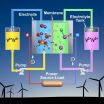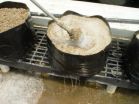(Press-News.org) Of around seven land vertebrate species whose survival in the wild is threatened one is also kept in captivity. These and other data on the protection of species in zoos and aquaria have now been revealed by scientists at the Max Planck Institute for Demographic Research (MPIDR) in Rostock. Writing in the journal Science, the team of researchers and the International Species Information System (ISIS) advocate the establishment of targeted captive breeding programmes to supplement the protection of animals in the wild. To do this, zoos should team up in networks and shelter these animals, as a form of life insurance, until they can be released back into the wild.
The researchers used data from the International Species Information System (ISIS) to calculate how many of the endangered species can already be found at zoological gardens: 20 to 25 percent of all endangered mammal species are kept at zoos. The overall figure for birds is only slightly less than that, but is much lower for avian species that are acutely at risk of extinction: only nine percent of these are found in captivity. Only three percent of endangered amphibian species are kept in captivity.
The role of zoos for species conservation must not be underestimated, Dalia Conde and Alexander Scheuerlein have stressed. "While it is true that the number of endangered species and individual animals at any one zoo is small", say the biologists, who conduct their research at the MPIDR's Laboratory of Evolutionary Biodemography, "if several institutions link up, zoological gardens will have a considerable collective potential to breed endangered animal species."
Specialist zoos for greater breeding success
The Science authors advocate the establishment of "specialist zoos" that concentrate on breeding just one or a small number of species: "Specialisation generally increases breeding success", say Conde and Scheuerlein. "The animals can be 'parked' at these zoos until they have a chance of survival in the natural environment and can then be returned to the wild." Nate Flesness, who is the scientific director of largest data holdings of zoos (ISIS), and is also co-author of the paper stressed hat it also makes a lot of sense to include animals in breeding programmes at an early stage, before their stocks in the wild decline too much. "Zoos should not be regarded as a last-resort emergency ward, because the chances of successful breeding are decreased if the last surviving, weakened individuals of a species need to be used for this purpose."
Recently, the International Union for Conservation of Nature (IUCN) has also determined how successful captive breeding is at supporting species protection: breeding at zoos has played a key role in 17 of the 68 vertebrate species whose risk status has now been downgraded by the organisation. Examples of these success stories include the Asiatic wild horse (Przewalski's horse), the black-footed ferret (a member of the mustelid family) and the Californian condor.
Breeding programmes at zoos also deliver new demographic data which are useful in species conservation: When is the onset of sexual maturity in an animal species? What is its litter or clutch size? At what intervals does a species reproduce? "Such fundamental data on their demographic development are unknown for many species", say Dalia Conde and Alexander Scheuerlein. "However, they are urgently needed to allow us to estimate the future fate of a species and its chances of survival in the wild".
INFORMATION:
Max Planck researchers urge more prominent role for zoos
2011-03-18
ELSE PRESS RELEASES FROM THIS DATE:
Heart damage improves, reverses after stem cell injections in a preliminary human trial
2011-03-18
Researchers have shown for the first time that stem cells injected into enlarged hearts reduced heart size, reduced scar tissue and improved function to injured heart areas, according to a small trial published in Circulation Research: Journal of the American Heart Association.
Researchers said that while this research is in the early stages, the findings are promising for the more than five million Americans who have enlarged hearts due to damage sustained from heart attacks. These patients can suffer premature death, have major disability and experience frequent hospitalizations. ...
Upgrading the vanadium redox battery
2011-03-18
RICHLAND, Wash. – Though considered a promising large-scale energy storage device, the vanadium redox battery's use has been limited by its inability to work well in a wide range of temperatures and its high cost. But new research indicates that modifying the battery's electrolyte solution significantly improves its performance. So much so that the upgraded battery could improve the electric grid's reliability and help connect more wind turbines and solar panels to the grid.
In a paper published by the journal Advanced Energy Materials, researchers at the Department of ...
Optimizing yield and fruit size of figs
2011-03-18
SOUTH AFRICA—The common fig is a subtropical, deciduous fruit tree grown in most Mediterranean-type climates. Although some believe that figs may be the oldest cultivated fruit species on earth, global expansion of fig crops has been hindered by the narrow research base pertaining to production practices and the limited number of fig cultivars currently available. Recently, three black figs were established in the Mediterranean-type climate of Western Cape Province of South Africa to provide fruit for fresh markets throughout South Africa and Europe.
Hein J. Gerber, Willem ...
New software calculates heating costs in greenhouse operations
2011-03-18
TOLEDO, OH—In parts of the United States where ornamental and vegetable plants are produced in greenhouses during cold seasons, heating costs are second only to labor costs for greenhouse operators. Greenhouse growers are faced with important management decisions that rely on understanding how temperature settings, heating systems, fuel types, and construction decisions influence their heating costs. To address the lack of user-friendly computer programs currently available for calculating heating costs in greenhouse operations, scientists have created a state-of-the-art ...
Recycling perlite: New, improved method saves resources
2011-03-18
BOSSIER CITY, LA—Perlite, a processed volcanic mineral, is widely used as a component of soilless growing mixes. Lightweight, sterile, and easy to use, perlite is popular with greenhouse growers. But because salt and pathogen buildup can occur when perlite is reused, it must be replaced every year or two to minimize the risk of crop failure. The cost of disposing of old material and replacing it with new perlite can be significant and often prohibitive for smaller greenhouse operations. Hanna Y. Hanna, a researcher at Louisiana State University Agricultural Center's Red ...
Horticulture students link problem-solving to employment
2011-03-18
AMES, IA—Recognizing the need for university students to develop problem-solving skills they will need in their careers, educators are looking to student-centered, problem-based learning strategies. Problem-based learning (PBL) experiences have been shown to promote higher-order thinking skills in students, but, for faculty, implementing and assessing problem-based activities often means a substantial time investment. Iowa State University professor Ann Marie VanDerZanden and graduate student Tigon Woline published a study in HortTechnology that reported on an innovative ...
Berkeley Lab scientists take a look at systems biology and cellular networking
2011-03-18
Systems biology is a holistic approach to the study of how a living organism emerges from the interactions of the individual elements that make up its constituent cells. Embracing a broad range of disciplines, this field of science that is just beginning to come into public prominence holds promise for advances in a number of important areas, including safer, more effective pharmaceuticals, improved environmental remediation, and clean, green, sustainable energy. However, the most profound impact of systems biology, according to one of its foremost practitioners, is that ...
Gardening linked to increased vegetable consumption in older adults
2011-03-18
COLLEGE STATION, TX—New research from Texas A&M University and Texas State University found that older adults who participate in gardening may be more likely to eat their veggies. The report, published in HortTechnology, presents the results of an online survey of adults aged 50+ and includes recommendations for promoting gardening "intervention" programs to older adults.
According to researchers Aime Sommerfeld, Amy McFarland, Tina Waliczek, and Jayne Zajicek, studies have shown that poor nutrition is one of several factors responsible for mortality and morbidity in ...
Corn gluten meal tested on squash survival, yields
2011-03-18
LANE, OK—Corn gluten meal, a powdery byproduct of the wet-milling process of corn, has shown important potential for use as an organic, non-selective preemergence or preplant-incorporated herbicide. A team of researchers from the U.S. Department of Agriculture-Agricultural Research Service and Oklahoma State University recently reported on the impact of corn gluten meal (CGM) applications on direct-seeded squash (Cucurbita pepo), and determined that CGM can be effective and safe if used in banded applications.
Used for years as a supplement in dog, fish, and livestock ...
Want more zest for life? Consider gardening!
2011-03-18
COLLEGE STATION, TX—Does gardening contribute to quality of life and increased wellness for older adults? Researchers from the Texas A&M and Texas State Universities asked these questions in a survey of people aged 50 and older. The survey revealed some compelling reasons for older adults to get themselves out in the garden.
Aime Sommerfeld, Jayne Zajicek, and Tina Waliczek designed a questionnaire to investigate older adult gardeners' and nongardeners' perceptions of personal life satisfaction and levels of physical activity. According to Sommerfeld, lead author of the ...





